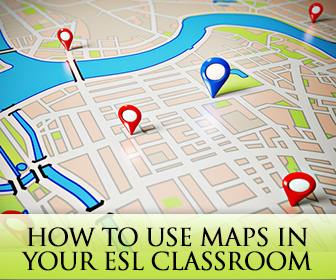Where Do We Go from Here? 6 Simple Ways to Use Maps in Your ESL Classroom


To get them ready, try a unit on travel, but you do not have to limit the lessons to vocabulary class. Here are some travel related activities that you can use across the ESL curriculum as your students continue their English fluency journey.

Travel magazines are fun to look at and help a vacationer imagine what his or her trip might be like. Collect some travel magazines from friends and family or request them from the library for this activity. Ask each person in your class to choose an article that describes a popular vacation destination and read it. After a first reading, ask the person to deconstruct the article into outline form, noting the important points the author makes. After each person has looked in detail at the article, ask him or her to write five multiple choice questions that can be answered by reading the article. Each student should then exchange the article and the questions (not the outline) with another student who should read the article and then answer the questions. Each student should check his partner’s answers and explain any errors. If you would like to extend this activity into writing, you can also ask a second student to write an article based on the outline created by the article’s first reader. Then, give each student a chance to compare the article that he wrote with the original article from which the outline was made.
If your students are at the level where they can write essays, travel and vacation make great topics for a compare/contrast essay. Start by putting students into groups of three or four to discuss some of the most interesting places they have visited. These may be locations close to home or exotic destinations around the world. Encourage students to share details about the experience: what they ate, what they did, what they saw. Then have each person choose two locations to write about in a compare/contrast essay. This type of essay can follow two organizational patterns, and you should review them with your students. Both styles of essay will start with an introduction and end with a conclusion, but the body of each style essay will have organizational differences. In a block style essay, the body of the essay will have two paragraphs, and each paragraph will discuss one of the locations about which your student is writing. In a point-by-point style essay, students should choose three points of comparison between the two locations. Each of the three body paragraphs will discuss one point of comparison and will address both of the locations. As always, encourage your students to use sensory details when they write, so the reader can feel as if he or she is at the vacation destination.
Whether your class is dramatic or not, planning and then performing a commercial about a vacation destination can be fun and entertaining for the entire class. Start by dividing your class into three or four groups (or more if you have a large class) and ask each group to choose a vacation destination about which to create a commercial advertisement. You may want to have some travel magazines available for them to look through for inspiration or give them internet access time to do research. Ask each team to create a 90-second television commercial for the location they choose making sure each person in the group has a speaking part in the commercial. You can encourage your class to be creative and entertaining. Once the commercials are finished, either have each group perform their commercial live or have each group record their commercial and have a screening in class. If you choose the second option, you may be able to use the commercial for grading and self-evaluation purposes and, of course, an excuse to have popcorn in class!
Part of taking a vacation is packing the correct items to take along. To make the best decisions, the vacationer must think about the activities he or she will engage in during the vacation. In pairs, have students choose a vacation destination and then discuss, using the future tense, what they will do once there. Each person should share his or her plans along with the necessary items to pack. Your students should use phrases such as, “I will go swimming, so I will pack a bathing suit.” This review of the simple future is especially helpful for beginning grammar students but still has value for those further along in their studies. If you like, you may also want your student pairs to make a list of the items they decide to bring and then share with the rest of the class.
Before summer vacation rolls around this year, give your students a chance to think about their own dream destinations with this unit on vacation, which spans the ESL curriculum. Moreover, if anyone does take a vacation because of what she learned in class, ask her to share from her real life experiences once she gets back.
What are some of your most memorable vacation destinations? Where would you go if you could go anywhere in the world?